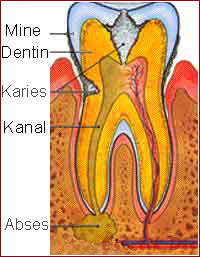
Why channels are treated?
Firstly, it must be kept in the mind that nothing can fully replace a natural tooth. Because of it, we can protect our natural teeth. One of the protective methods for an ill tooth is channel treatment. Channel treatment is a support to protection of the injured tooth. When dental pulp (soft tissue inside the tooth covering nerves, blood and lymph) is injured to the level that it cannot repair itself, it dies. Generally, it is caused by bacteria existing in broken teeth and deep decays. Bacteria cause inflammation of tooth in which they exist. If injured or sick dental pulp is not treated, tooth and the surrounding tissues will be inflamed. At the result you can lose your tooth completely.
What is channel treatment and how it is applied?
Channel treatment is a treatment way applied when dental pulp is injured. In earlier time when the soft tissue of the tooth was ill, the only solution was the extraction of the tooth, whereas at present time it is possible to treat such teeth.
What can happen if channels are not treated?
In case when there is deep decay and crack and the dental pulp cannot repair itself, the tooth loses its healthy look and the infection can spread to the whole tooth. If the channel treatment is not carried out, infection can reach even the tissues in the tip of the tooth root. The jaw bone surrounding the tooth also gets inflamed and abscess is formed in the appeared hollow. To this situation pain and swelling can be added and at the result, the tooth can be lost shortly.
The stages of channel treatment:
1. Firstly, the tooth is anesthetized for a painless treatment.
2. Then the decay is cleaned, ill soft tissue is extracted until reaching the tooth. Nerve and tissue debris are cleaned.
3. The channel is shaped until the tip of the root. If necessary, some medicines can be applied in order to speed up the recovery.
4. The surface of the tooth is covered with temporary filling substance between the sessions until the tooth recovers. When the inflammation process and inflammation in the tip of the root are stopped, the channel is filled with a special filling material until the tip of the root.
5. In some cases there is no need for all these sessions, as the channel is treated in one session.
How long is the life of the tooth the channel of which has been treated?
If there is not a repeated infection in the tooth and if appropriate measures are taken to prevent the decay, the filling can be used life-long. If you visit your dentist regularly, you can find out existence of the infection in an early stage. Good mouth hygiene also prevents appearance of repeated decay.

Formation of decay and abscess.